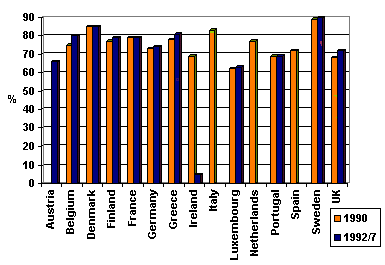8. Demographic changes do not occur in a vacuum. Family life, social attitudes and values, gender roles and working arrangements are changing. Economic, social, political and cultural trends will influence how women age. These trends will also have important consequences for women’s health and quality of life. This section highlights some important socio-economic issues for women.
Marriage and Divorce
9. Women’s lives have changed significantly throughout Europe. There is a general decline in marriage rates and an increase in the number of divorces across Europe. In 1998, the rate of marriage in the EU was estimated at 5 per 1,000 population compared to 6.3 in 1980. At the same time, the average age of first marriage and the average age at first birth are also rising.
Marriages and Divorces in the EU (1960-95)
| Country | Marriages | Divorces | |||||||||||||||||||||||||||||
| No. in 1995 | Difference since 1960 (%) | Rate in 1995 (%) | Difference since 1960 (%) | No. in 1995 | Difference since 1960 (%) | Rate in 1995 (%) | Difference since 1960 (%) | ||||||||||||||||||||||||
| EU15 | 1901000 | -24.1 | 5.1 | -54.4 | 677500 | 297.7 | 1.8 | 237.7 | |||||||||||||||||||||||
| Portugal | 65800 | -5.3 | 6.6 | -18.2 | 12300 | 1545.1 | 1.2 | 1369.5 | |||||||||||||||||||||||
| Austria | 42900 | -26.6 | 5.3 | -55.6 | 18200 | 127.2 | 2.3 | 99.0 | |||||||||||||||||||||||
| Italy | 283000 | -27.0 | 4.9 | -57.4 | 27000 | – | 0.5 | – | |||||||||||||||||||||||
| Germany | 430500 | -37.5 | 5.3 | -79.8 | 169400 | 130.8 | 2.1 | 105.9 | |||||||||||||||||||||||
| France | 254000 | -20.6 | 4.4 | -60.3 | 117000 | 287.6 | 2.0 | 204.1 | |||||||||||||||||||||||
| Finland | 23700 | -27.7 | 4.6 | -59.5 | 14000 | 283.7 | 2.7 | 232.8 | |||||||||||||||||||||||
| Belgium | 51500 | -21.0 | 5.1 | -40.7 | 35000 | 662.3 | 3.5 | 586.0 | |||||||||||||||||||||||
| Spain | 196900 | -16.9 | 5.0 | -53.9 | 33100 | – | 0.8 | – | |||||||||||||||||||||||
| UK | 321000 | -18.4 | 5.5 | -37.1 | 170100 | 559.0 | 2.9 | 489.0 | |||||||||||||||||||||||
| Luxembourg | 2100 | -7.2 | 5.1 | -40.7 | 700 | 375.2 | 1.8 | 264.1 | |||||||||||||||||||||||
| Greece | 64000 | 10.0 | 6.1 | -14.2 | 11000 | 346.4 | 1.1 | 255.0 | |||||||||||||||||||||||
| Denmark | 34700 | -3.2 | 6.6 | -18.0 | 13000 | 94.2 | 2.5 | 70.0 | |||||||||||||||||||||||
| Sweden | 33600 | -32.9 | 3.8 | -75.9 | 22500 | 151.5 | 2.6 | 113.1 | |||||||||||||||||||||||
| Netherlands | 81500 | -8.6 | 5.3 | -47.2 | 34200 | 502.4 | 2.2 | 345.4 | |||||||||||||||||||||||
| Ireland | 15600 | 1.0 | 4.4 | -25.2 | – | – | – | – | |||||||||||||||||||||||
Source: Eurostat Database 1997
Women and Work
10. Women are increasingly becoming an essential part of the labour force. For example, in all developed regions women make up the largest proportion of those working in the services sector, and the smallest proportion of those working in agriculture.
Percentage distribution of the labour force by sex 1990/1997
| Developed Regions |
Female Labour Force | Male Labour Force | ||||
| Agriculture | Industry | Services | Agriculture | Industry | Services | |
| Eastern Europe |
16 | 29 | 55 | 17 | 44 | 39 |
| Western Europe |
5 | 16 | 79 | 7 | 38 | 55 |
| Other Developed Regions |
3 | 13 | 84 | 5 | 31 | 64 |
Source: Statistics Division of the United Nations Secretariat (1999) Key Indicators of the Labour Market.
11. In the European Union, female employment has grown four times faster in comparison to male employment since 1994 (European Commission, 2000). Yet, women continue to represent the largest reserve of non-employed and under-employed skilled labour within the EU.
Percentage distribution of the labour force by sex 1990/1997
| Country | Waged and salaried workers | Self employed workers | Contributing family workers | |||
| Women | Men | Women | Men | Women | Men | |
| Portugal | 73 | 71 | 26 | 28 | 2 | 1 |
| Austria | 87 | 86 | 9 | 12 | 5 | 2 |
| Italy | 77 | 68 | 17 | 29 | 7 | 3 |
| Germany | 92 | 87 | 6 | 13 | 2 | 0 |
| France | – | – | – | – | – | – |
| Finland | 90 | 81 | 10 | 18 | 1 | 1 |
| Belgium | 82 | 81 | 10 | 18 | 8 | 1 |
| Spain | 79 | 75 | 15 | 24 | 5 | 2 |
| UK | 92 | 83 | 7 | 17 | 1 | 0 |
| Luxembourg | – | – | – | – | – | – |
| Greece | 58 | 53 | 19 | 42 | 24 | 5 |
| Denmark | 95 | 88 | 6 | 12 | 0 | 0 |
| Sweden | 94 | 85 | 5 | 15 | 1 | 0 |
| Netherlands | 90 | 87 | 8 | 13 | 2 | 0 |
| Ireland | 91 | 72 | 8 | 27 | 2 | 1 |
Source: Yearbook of Labour Statistics (1998) Key Indicators in the Labour Market.
12. The unemployment rate for women in the EU is higher for women than for men in all countries except France, the UK, Sweden and Ireland.
Unemployment Rate ( % ) Aged 15 – 64
| Country | Female 1997 | Male 1997 |
| Portugal | 7.9 | 6.2 |
| Austria | 5.3 | 5.1 |
| Italy | 16.8 | 9.8 |
| Germany | 11.0 | 9.0 |
| France | 10.9 | 14.2 |
| Finland | 15.1 | 13.9 |
| Belgium | 11.6 | 7.1 |
| Spain | 28.4 | 16.2 |
| United Kingdom | 5.8 | 8.2 |
| Luxembourg | – | – |
| Greece | 15.1 | 6.4 |
| Denmark | 6.5 | 4.6 |
| Sweden | 7.5 | 8.5 |
| Netherlands | 7.2 | 4.4 |
| Ireland | 10.4 | 10.6 |
Source: UN Development Programme (1999) Human Development Report
13. There is still evidence of wage differences between men and women in the EU despite the existence of equal pay legislation. The Nordic member states of the EU have the highest rates of gender equality, partly because of high levels of income in relation to men and partly because of high levels of education.
Womens’ wages in manufacturing as a percentage of mens’ wages
Source: Womens’ Indicators and Statistics Database. (1998) Yearbook of Labour Statistics 1977-1998. Geneva.

